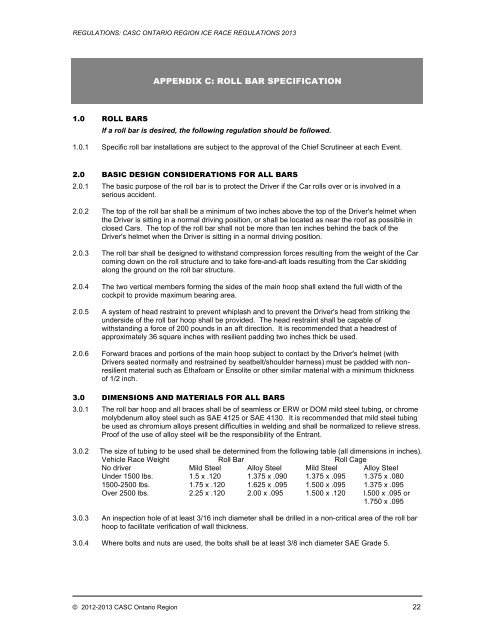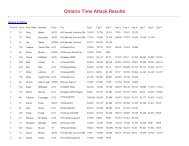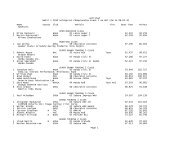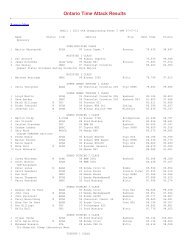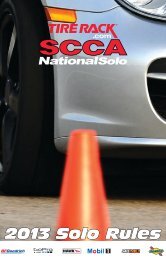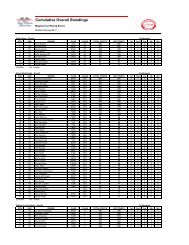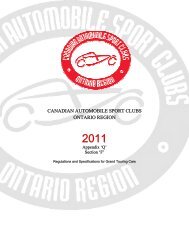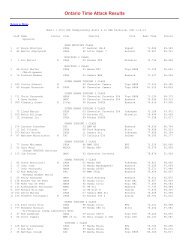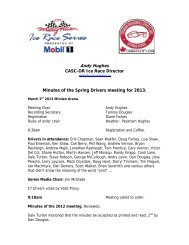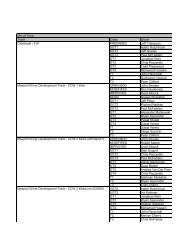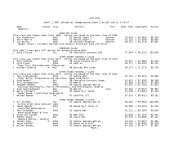2013 Rules and Regulations - CASC, Ontario Region
2013 Rules and Regulations - CASC, Ontario Region
2013 Rules and Regulations - CASC, Ontario Region
Create successful ePaper yourself
Turn your PDF publications into a flip-book with our unique Google optimized e-Paper software.
REGULATIONS: <strong>CASC</strong> ONTARIO REGION ICE RACE REGULATIONS <strong>2013</strong><br />
APPENDIX C: ROLL BAR SPECIFICATION<br />
1.0 ROLL BARS<br />
If a roll bar is desired, the following regulation should be followed.<br />
1.0.1 Specific roll bar installations are subject to the approval of the Chief Scrutineer at each Event.<br />
2.0 BASIC DESIGN CONSIDERATIONS FOR ALL BARS<br />
2.0.1 The basic purpose of the roll bar is to protect the Driver if the Car rolls over or is involved in a<br />
serious accident.<br />
2.0.2 The top of the roll bar shall be a minimum of two inches above the top of the Driver's helmet when<br />
the Driver is sitting in a normal driving position, or shall be located as near the roof as possible in<br />
closed Cars. The top of the roll bar shall not be more than ten inches behind the back of the<br />
Driver's helmet when the Driver is sitting in a normal driving position.<br />
2.0.3 The roll bar shall be designed to withst<strong>and</strong> compression forces resulting from the weight of the Car<br />
coming down on the roll structure <strong>and</strong> to take fore-<strong>and</strong>-aft loads resulting from the Car skidding<br />
along the ground on the roll bar structure.<br />
2.0.4 The two vertical members forming the sides of the main hoop shall extend the full width of the<br />
cockpit to provide maximum bearing area.<br />
2.0.5 A system of head restraint to prevent whiplash <strong>and</strong> to prevent the Driver's head from striking the<br />
underside of the roll bar hoop shall be provided. The head restraint shall be capable of<br />
withst<strong>and</strong>ing a force of 200 pounds in an aft direction. It is recommended that a headrest of<br />
approximately 36 square inches with resilient padding two inches thick be used.<br />
2.0.6 Forward braces <strong>and</strong> portions of the main hoop subject to contact by the Driver's helmet (with<br />
Drivers seated normally <strong>and</strong> restrained by seatbelt/shoulder harness) must be padded with nonresilient<br />
material such as Ethafoam or Ensolite or other similar material with a minimum thickness<br />
of 1/2 inch.<br />
3.0 DIMENSIONS AND MATERIALS FOR ALL BARS<br />
3.0.1 The roll bar hoop <strong>and</strong> all braces shall be of seamless or ERW or DOM mild steel tubing, or chrome<br />
molybdenum alloy steel such as SAE 4125 or SAE 4130. It is recommended that mild steel tubing<br />
be used as chromium alloys present difficulties in welding <strong>and</strong> shall be normalized to relieve stress.<br />
Proof of the use of alloy steel will be the responsibility of the Entrant.<br />
3.0.2 The size of tubing to be used shall be determined from the following table (all dimensions in inches).<br />
Vehicle Race Weight Roll Bar Roll Cage<br />
No driver Mild Steel Alloy Steel Mild Steel Alloy Steel<br />
Under 1500 lbs. 1.5 x .120 1.375 x .090 1.375 x .095 1.375 x .080<br />
1500-2500 lbs. 1.75 x .120 1.625 x .095 1.500 x .095 1.375 x .095<br />
Over 2500 lbs. 2.25 x .120 2.00 x .095 1.500 x .120 l.500 x .095 or<br />
1.750 x .095<br />
3.0.3 An inspection hole of at least 3/16 inch diameter shall be drilled in a non-critical area of the roll bar<br />
hoop to facilitate verification of wall thickness.<br />
3.0.4 Where bolts <strong>and</strong> nuts are used, the bolts shall be at least 3/8 inch diameter SAE Grade 5.<br />
© 2012-<strong>2013</strong> <strong>CASC</strong> <strong>Ontario</strong> <strong>Region</strong> 22


